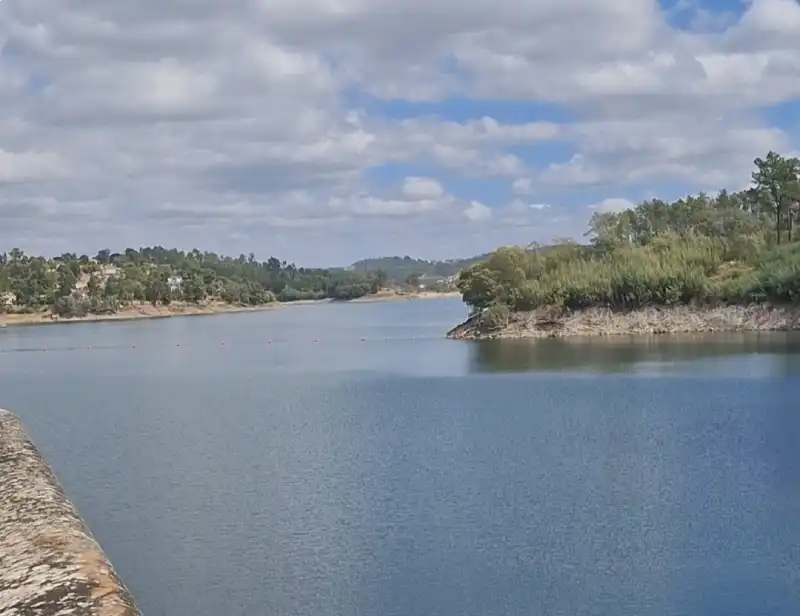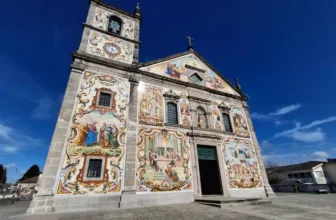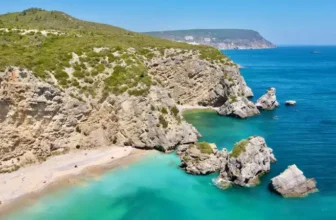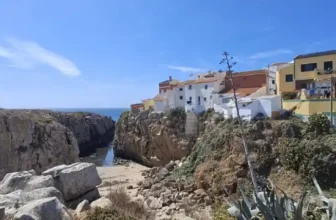Things To Do In Tomar
Welcome to Tomar, Portugal – a hidden gem packed with history, charm, and endless things to do! If you’re into knights, castles, and a bit of mystery, you’re in the right place.
Tomar was founded in 1160, making it over 860 years old. It was established by a grand master of the Knights Templar, as the headquarters of the order in Portugal. The town played a significant role in the country’s medieval history.
The town is a fascinating blend of history, rich heritage, and vibrant local culture. It seamlessly mixes ancient architecture, with charming cobblestone streets, lively festivals, and serene natural landscapes, offering a unique combination of history, tradition, and scenic beauty. Its only 90 minutes from Lisbon so a great day trip option.
Lets jump into 10 things to do in Tomar.
Tomar was founded in 1160, making it over 860 years old. It was established by a grand master of the Knights Templar, as the headquarters of the order in Portugal. The town played a significant role in the country’s medieval history.
The town is a fascinating blend of history, rich heritage, and vibrant local culture. It seamlessly mixes ancient architecture, with charming cobblestone streets, lively festivals, and serene natural landscapes, offering a unique combination of history, tradition, and scenic beauty. Its only 90 minutes from Lisbon so a great day trip option.
Lets jump into 10 things to do in Tomar.
Mata Nacional dos Sete Montes
f you’re craving some nature, head to the Mata Nacional dos Sete Montes, a peaceful park perfect for a stroll or picnic. Or, if water’s more your thing, enjoy the calming views of the Nabão River running right through town.
Mata Nacional dos Sete Montes in Tomar is a lush, historic forest offering a serene escape into nature. Spanning over 200 hectares, this expansive park features diverse flora, shaded walking trails, and picturesque picnic areas. Originally planted in the 19th century to supply timber for the town, the forest now serves as a popular recreational area. Visitors can explore its well-maintained paths, enjoy the tranquil ambiance, and spot various bird species. The park’s natural beauty and historical significance make it a delightful destination for nature lovers and those seeking a peaceful retreat.
Address: 2300-000 Tomar, Portugal
Mata Nacional dos Sete Montes in Tomar operates on seasonal schedules:
Summer (April to October): Open from 8:30 AM to 7:30 PM, with the last entry permitted at 7:00 PM.
Winter (November to March): Open from 8:30 AM to 5:30 PM, with the last entry allowed at 5:00 PM.
The park remains closed on January 1, Easter Sunday, May 1, and December 25
Mata Nacional dos Sete Montes in Tomar is a lush, historic forest offering a serene escape into nature. Spanning over 200 hectares, this expansive park features diverse flora, shaded walking trails, and picturesque picnic areas. Originally planted in the 19th century to supply timber for the town, the forest now serves as a popular recreational area. Visitors can explore its well-maintained paths, enjoy the tranquil ambiance, and spot various bird species. The park’s natural beauty and historical significance make it a delightful destination for nature lovers and those seeking a peaceful retreat.
Address: 2300-000 Tomar, Portugal
Mata Nacional dos Sete Montes in Tomar operates on seasonal schedules:
Summer (April to October): Open from 8:30 AM to 7:30 PM, with the last entry permitted at 7:00 PM.
Winter (November to March): Open from 8:30 AM to 5:30 PM, with the last entry allowed at 5:00 PM.
The park remains closed on January 1, Easter Sunday, May 1, and December 25
Old Town
Wandering through the narrow, cobbled streets of Tomar’s old town, you’ll encounter picturesque squares, traditional whitewashed houses, and inviting local shops and cafes.
At the heart of the old town is the Praça da República, a picturesque square dominated by the Church of São João Baptista, a perfect spot to relax and soak in the atmosphere.
For dining, the old town offers a range of traditional Portuguese restaurants and cozy cafés. You can enjoy local delicacies like “bacalhau à brás” (salted cod) or “leitão” (roast suckling pig) at popular spots like O Tabuleiro or Taverna Antiqua, which both offer authentic regional dishes in a rustic, inviting setting. If you’re craving something sweet, don’t miss the famous “Fatias de Tomar,” a traditional local dessert.
Shopping in Tomar’s old town is equally delightful. Along the main streets, you’ll find small boutiques and artisan shops selling local crafts, ceramics, and handmade jewelry. It’s a great place to pick up unique souvenirs, from traditional Portuguese tiles to handcrafted wooden items. The town’s warm, friendly vibe makes it easy to spend hours exploring and enjoying everything the old town has to offer.
With its blend of historical grandeur and quaint, old-world charm, Tomar’s old town is a captivating destination for history enthusiasts and casual visitors alike.
At the heart of the old town is the Praça da República, a picturesque square dominated by the Church of São João Baptista, a perfect spot to relax and soak in the atmosphere.
For dining, the old town offers a range of traditional Portuguese restaurants and cozy cafés. You can enjoy local delicacies like “bacalhau à brás” (salted cod) or “leitão” (roast suckling pig) at popular spots like O Tabuleiro or Taverna Antiqua, which both offer authentic regional dishes in a rustic, inviting setting. If you’re craving something sweet, don’t miss the famous “Fatias de Tomar,” a traditional local dessert.
Shopping in Tomar’s old town is equally delightful. Along the main streets, you’ll find small boutiques and artisan shops selling local crafts, ceramics, and handmade jewelry. It’s a great place to pick up unique souvenirs, from traditional Portuguese tiles to handcrafted wooden items. The town’s warm, friendly vibe makes it easy to spend hours exploring and enjoying everything the old town has to offer.
With its blend of historical grandeur and quaint, old-world charm, Tomar’s old town is a captivating destination for history enthusiasts and casual visitors alike.
The Rio Nabão and its surrounding park
The Rio Nabão and its surrounding park in Tomar offer a picturesque retreat in the heart of the town. The river winds gracefully through the landscape, providing scenic views and a tranquil atmosphere. The adjacent park features lush greenery, walking paths, and shaded spots perfect for relaxation or a leisurely stroll. Visitors can enjoy the serene environment, observe local wildlife, and appreciate the natural beauty of the area. The park also serves as a popular spot for picnics and outdoor activities, making it an ideal destination for those looking to espace the summer sun and seeking a peaceful escape by the water.
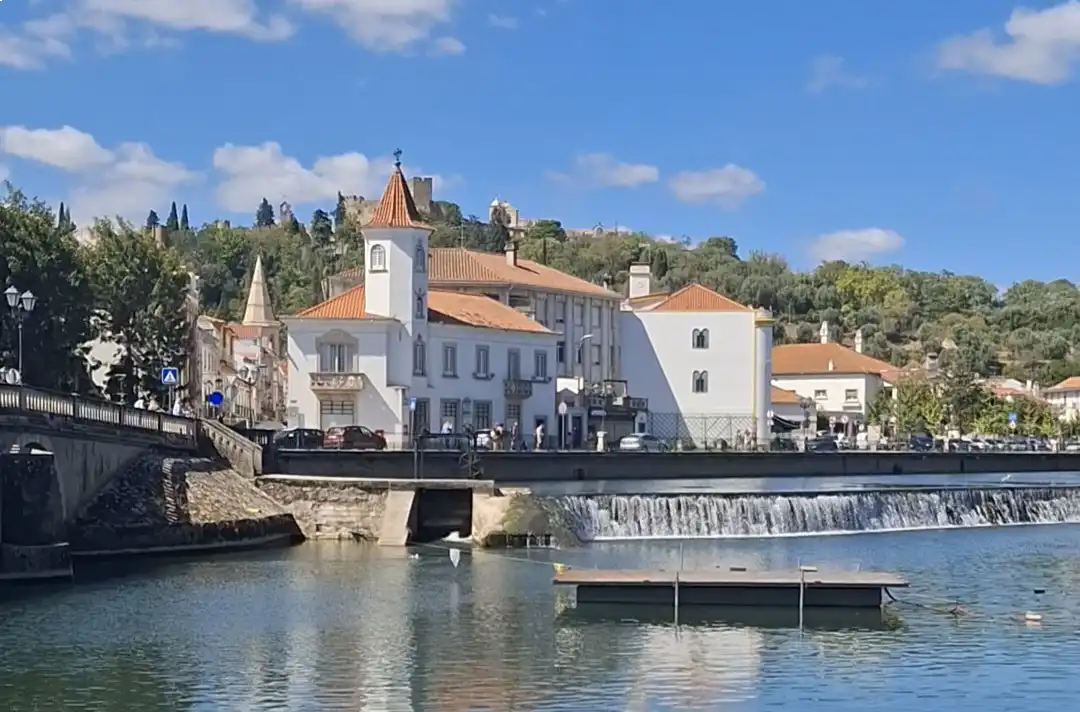
Church of São João Baptista
The Church of São João Baptista, located in the central Praça da República in Tomar, Portugal, is a stunning example of late Gothic and Manueline architecture. Built in the 15th century, it reflects the town’s rich historical ties to the Knights Templar. Its elegant façade features a beautiful Manueline portal, and the tall bell tower is a landmark in the town. Inside, the church is adorned with azulejos (traditional Portuguese tiles), intricate stonework, and notable paintings, including works by Gregório Lopes. This church holds a special place in Tomar’s cultural and religious heritage, blending artistic and historical significance.
Address: Praça da República, 2300-550 Tomar, Portugal
Opening Hours: Monday to Saturday: 10:00 AM – 12:30 PM and 2:30 PM – 7:30 PM Sunday: 9:00 AM – 12:30 PM
Closed on Sunday afternoon and evening.
Address: Praça da República, 2300-550 Tomar, Portugal
Opening Hours: Monday to Saturday: 10:00 AM – 12:30 PM and 2:30 PM – 7:30 PM Sunday: 9:00 AM – 12:30 PM
Closed on Sunday afternoon and evening.
Watch Things To Do In Tomar
Castelo Tomar
Castelo de Tomar, also known as the Castle of the Knights Templar, is a remarkable historical fortress located in Tomar, Portugal. Built in 1160 by Gualdim Pais, the fourth Grand Master of the Knights Templar in Portugal, the castle stands as a testament to the military and architectural prowess of the medieval era. The fortress was strategically positioned to defend the newly established Christian territories during the Reconquista and served as the headquarters for the Knights Templar in Portugal.
The castle’s architecture is a blend of Romanesque, Gothic, and Manueline styles, reflecting its long history and various phases of construction. One of the castle’s most striking features is the Charola, the Templar’s rotunda, inspired by the Church of the Holy Sepulchre in Jerusalem. This circular sanctuary, richly decorated with frescoes and gilded woodwork, was designed for the knights to pray without dismounting from their horses.
The castle is also part of the larger Convent of Christ complex, a UNESCO World Heritage site, highlighting its cultural and historical significance. Visitors to Castelo de Tomar can explore its well-preserved walls, towers, and battlements, offering stunning views of the surrounding landscape and the town of Tomar below. The castle’s rich history and architectural grandeur make it a must-visit destination for anyone interested in Portugal’s medieval past.
Address: Estrada do Convento, 2300-000 Tomar, Portugal
Opening Hours:
October to May: 9:00 AM to 5:30 PM (last entry at 5:00 PM)
June to September: 9:00 AM to 6:30 PM (last entry at 6:00 PM)
The castle’s architecture is a blend of Romanesque, Gothic, and Manueline styles, reflecting its long history and various phases of construction. One of the castle’s most striking features is the Charola, the Templar’s rotunda, inspired by the Church of the Holy Sepulchre in Jerusalem. This circular sanctuary, richly decorated with frescoes and gilded woodwork, was designed for the knights to pray without dismounting from their horses.
The castle is also part of the larger Convent of Christ complex, a UNESCO World Heritage site, highlighting its cultural and historical significance. Visitors to Castelo de Tomar can explore its well-preserved walls, towers, and battlements, offering stunning views of the surrounding landscape and the town of Tomar below. The castle’s rich history and architectural grandeur make it a must-visit destination for anyone interested in Portugal’s medieval past.
Address: Estrada do Convento, 2300-000 Tomar, Portugal
Opening Hours:
October to May: 9:00 AM to 5:30 PM (last entry at 5:00 PM)
June to September: 9:00 AM to 6:30 PM (last entry at 6:00 PM)
Charola
The Charola in Tomar is one of the most extraordinary and well-preserved examples of medieval religious architecture in Portugal. Situated within the Convent of Christ, this circular sanctuary was originally built in the 12th century as the private oratory for the Knights Templar, a powerful military order during the Crusades. The design of the Charola was inspired by the Church of the Holy Sepulchre in Jerusalem, reflecting the Templars’ deep connection to the Holy Land.
Architecturally, the Charola is a fascinating blend of Romanesque and Gothic styles, with later Manueline elements added during the 16th century. The structure is distinguished by its unique circular layout, which allowed the knights to attend services on horseback, symbolizing their constant readiness for battle. The interior is richly decorated, featuring stunning frescoes, intricate stone carvings, and gilded woodwork that exemplify the artistic achievements of the time.
The Charola’s central nave is surrounded by an ambulatory, with large windows that bathe the sanctuary in natural light, enhancing the spiritual atmosphere. The combination of religious symbolism, architectural innovation, and artistic detail makes the Charola a true masterpiece. It is not only a key part of the Convent of Christ, a UNESCO World Heritage site, but also a significant symbol of the Knights Templar’s legacy in Portugal. Visiting the Charola offers a profound glimpse into the spiritual and historical richness of the medieval period.
Opening Hours:
October to May: 9:00 AM to 5:30 PM (last entry at 5:00 PM)
June to September: 9:00 AM to 6:30 PM (last entry at 6:00 PM)
Address: Convento de Cristo, Terreiro Gualdim Pais, 2300-000 Tomar, Portugal
Architecturally, the Charola is a fascinating blend of Romanesque and Gothic styles, with later Manueline elements added during the 16th century. The structure is distinguished by its unique circular layout, which allowed the knights to attend services on horseback, symbolizing their constant readiness for battle. The interior is richly decorated, featuring stunning frescoes, intricate stone carvings, and gilded woodwork that exemplify the artistic achievements of the time.
The Charola’s central nave is surrounded by an ambulatory, with large windows that bathe the sanctuary in natural light, enhancing the spiritual atmosphere. The combination of religious symbolism, architectural innovation, and artistic detail makes the Charola a true masterpiece. It is not only a key part of the Convent of Christ, a UNESCO World Heritage site, but also a significant symbol of the Knights Templar’s legacy in Portugal. Visiting the Charola offers a profound glimpse into the spiritual and historical richness of the medieval period.
Opening Hours:
October to May: 9:00 AM to 5:30 PM (last entry at 5:00 PM)
June to September: 9:00 AM to 6:30 PM (last entry at 6:00 PM)
Address: Convento de Cristo, Terreiro Gualdim Pais, 2300-000 Tomar, Portugal
Convento de Cristo
The Convento de Cristo in Tomar is a UNESCO World Heritage site and a masterpiece of Portuguese architecture. Convent of Christ is the name usually given to the monument ensemble consisting of the Templar Castle of Tomar, the Renaissance Convent of the Order of Christ, the Charola.
Founded in the 12th century as the headquarters of the Knights Templar, the convent reflects a rich blend of Romanesque, Gothic, Manueline, and Renaissance styles.
The convent’s history spans centuries, embodying the spiritual, military, and artistic achievements of its time. Visiting the Convento de Cristo offers an immersive journey through Portugal’s medieval and Renaissance heritage.
Address:
Estrada do Convento, 2300-000 Tomar, Portugal
Opening Hours:
October to May:
9:00 AM to 5:30 PM (last entry at 5:00 PM)
June to September:
9:00 AM to 6:30 PM (last entry at 6:00 PM)
Founded in the 12th century as the headquarters of the Knights Templar, the convent reflects a rich blend of Romanesque, Gothic, Manueline, and Renaissance styles.
The convent’s history spans centuries, embodying the spiritual, military, and artistic achievements of its time. Visiting the Convento de Cristo offers an immersive journey through Portugal’s medieval and Renaissance heritage.
Address:
Estrada do Convento, 2300-000 Tomar, Portugal
Opening Hours:
October to May:
9:00 AM to 5:30 PM (last entry at 5:00 PM)
June to September:
9:00 AM to 6:30 PM (last entry at 6:00 PM)
Renaissance Convent of the Order of Christ
The Renaissance Convent of the Order of Christ in Tomar is a stunning architectural masterpiece that blends Gothic, Manueline, and Renaissance styles. Originally a Templar stronghold, it was transformed during the 16th century under King Manuel I and later King John III, who commissioned its most famous features. Its grand cloisters, ornate carvings, and intricate details reflect Portugal’s Age of Discoveries and the wealth of the Order of Christ. The convent’s highlight is the Manueline-style window of the Chapter House, a richly decorated symbol of Portugal’s maritime power. This UNESCO World Heritage site remains one of Portugal’s most iconic landmarks.
The Aqueduto de Tomar, or Aqueduct of Pegões
The Aqueduto de Tomar, or Aqueduct of Pegões, is a remarkable 17th-century structure built to supply water to the Convento de Cristo. Spanning nearly six kilometers, the aqueduct is an engineering marvel, featuring 180 arches that rise impressively across the landscape. Designed by Italian architect Filipe Terzi, it blends functionality with architectural beauty, showcasing Renaissance and Baroque influences. The aqueduct not only served a vital practical purpose but also stands as a testament to the ingenuity and skill of its creators. Today, it remains a significant historical landmark, offering stunning views and a glimpse into Portugal’s rich engineering heritage.
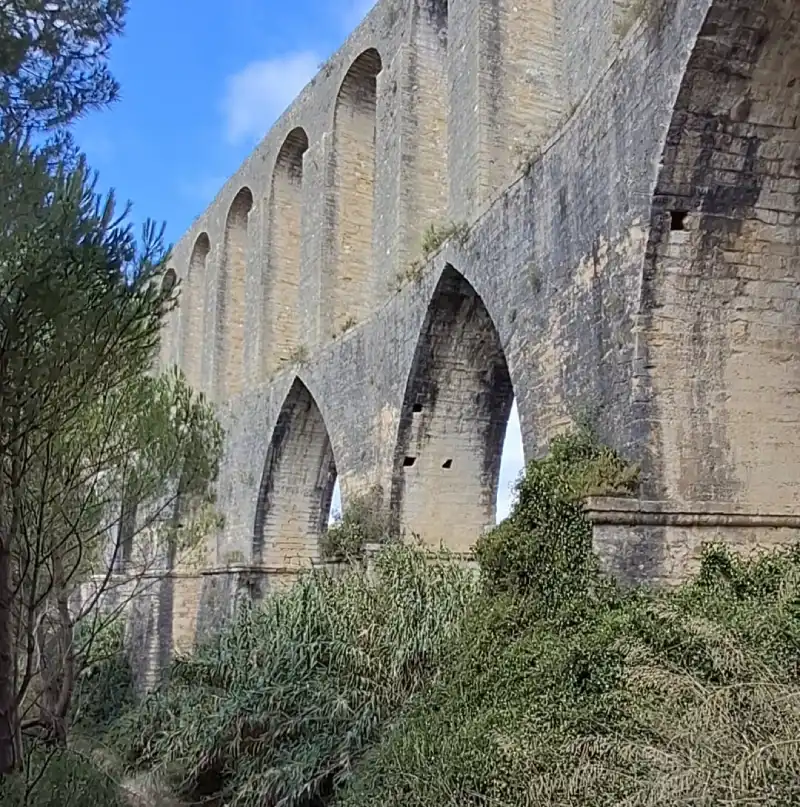
Castelo do Bode, The Zêzere River and River Beaches
The Zêzere River, winding through central Portugal, is a serene and picturesque waterway known for its crystal-clear waters and lush surroundings. One of its most notable features is the Castelo do Bode Dam, a massive structure that creates a stunning reservoir, perfect for water sports, fishing, and relaxation. The reservoir, with its calm, expansive waters, is a popular destination for boating and swimming. The area around Castelo do Bode offers breathtaking natural scenery, with rolling hills and dense forests, making it a beloved spot for both locals and tourists seeking tranquility and outdoor adventure in the heart of Portugal.
The Zêzere River is home to some of Portugal’s most beautiful river beaches, offering idyllic spots for relaxation and outdoor activities. These river beaches, known for their pristine waters and scenic surroundings, are perfect for swimming, sunbathing, and picnicking. Popular beaches like Praia Fluvial de Aldeia do Mato and Praia Fluvial de Fernandaires attract visitors with their tranquil atmosphere and well-maintained facilities. Surrounded by lush forests and rolling hills, these beaches provide a peaceful escape into nature, where you can enjoy the beauty of the Zêzere River while engaging in water sports, fishing, or simply unwinding by the water’s edge.
The Zêzere River is home to some of Portugal’s most beautiful river beaches, offering idyllic spots for relaxation and outdoor activities. These river beaches, known for their pristine waters and scenic surroundings, are perfect for swimming, sunbathing, and picnicking. Popular beaches like Praia Fluvial de Aldeia do Mato and Praia Fluvial de Fernandaires attract visitors with their tranquil atmosphere and well-maintained facilities. Surrounded by lush forests and rolling hills, these beaches provide a peaceful escape into nature, where you can enjoy the beauty of the Zêzere River while engaging in water sports, fishing, or simply unwinding by the water’s edge.
